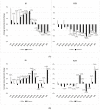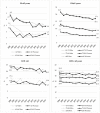Patients Hospitalized for Ischemic Stroke and Intracerebral Hemorrhage in France: Time Trends (2008-2019), In-Hospital Outcomes, Age and Sex Differences
- PMID: 35329995
- PMCID: PMC8949281
- DOI: 10.3390/jcm11061669
Patients Hospitalized for Ischemic Stroke and Intracerebral Hemorrhage in France: Time Trends (2008-2019), In-Hospital Outcomes, Age and Sex Differences
Abstract
Background: Rates of patients hospitalized for stroke increased among people aged under 65 years in France, as has been found in other countries.
Methods: To analyze time trends in the rates of patients hospitalized for ischemic stroke (IS) and intracerebral hemorrhage (ICH) in France between 2008 and 2019 and determine related short-term outcomes mainly, we selected all patients hospitalized for stroke using the French national hospital database.
Results: The average annual percentage change in the rates of patients hospitalized for IS increased significantly in men and women aged 50-64 years (+2.0%) and in men aged 18-34 years (+1.5%) and 35-44 years (+2.2%). A decrease in the average annual percentage change was observed for IS among people aged over 75 years and among those over 50 years for ICH. After adjustment on confounding factors, women were less likely to die in hospital. Case fatality rates decreased overtime in all age groups for both sexes, with a more pronounced decrease for IS than ICH.
Conclusions: The increasing trend of IS among adults under 65 years is ongoing, highlighting the urgent need for stroke prevention programs in that age. For the first time, we recorded a decrease in the rates of patients hospitalized for ICH among the population over 50 years.
Keywords: hospitalization; intracerebral hemorrhage; ischemic stroke; outcomes; temporal trends.
Conflict of interest statement
Yannick Béjot declared having received consulting fees from NovoNordisk and payment or honoraria from BMS, Pfizer, Medtronic, Amgen, Boehringer-Ingelheim, and Servier outside the submitted work. The other authors declared no conflict of interest with the presented work.
Figures




Similar articles
-
Trends in One Month and One Year Hemorrhagic Stroke Case Fatality Rates in the Czech Republic between 1998 and 2015.J Stroke Cerebrovasc Dis. 2020 Jun;29(6):104762. doi: 10.1016/j.jstrokecerebrovasdis.2020.104762. Epub 2020 Apr 5. J Stroke Cerebrovasc Dis. 2020. PMID: 32268973
-
National Trends in Patients Hospitalized for Stroke and Stroke Mortality in France, 2008 to 2014.Stroke. 2017 Nov;48(11):2939-2945. doi: 10.1161/STROKEAHA.117.017640. Epub 2017 Sep 29. Stroke. 2017. PMID: 28970279
-
Determinants of Case Fatality After Hospitalization for Stroke in France 2010 to 2015.Stroke. 2019 Feb;50(2):305-312. doi: 10.1161/STROKEAHA.118.023495. Stroke. 2019. PMID: 30621528
-
Sex Differences in the Epidemiology of Intracerebral Hemorrhage Over 10 Years in a Population-Based Stroke Registry.J Am Heart Assoc. 2024 Mar 5;13(5):e032595. doi: 10.1161/JAHA.123.032595. Epub 2024 Feb 27. J Am Heart Assoc. 2024. PMID: 38410943 Free PMC article.
-
Time trends in incidence, case fatality, and mortality of intracerebral hemorrhage.Neurology. 2015 Oct 13;85(15):1318-24. doi: 10.1212/WNL.0000000000002015. Epub 2015 Sep 16. Neurology. 2015. PMID: 26377254
Cited by
-
Neutrophil-lymphocyte ratio: A simple and accurate biomarker for the prognosis of patients with intracerebral bleeding, a study of 115 cases.Surg Neurol Int. 2024 Dec 27;15:475. doi: 10.25259/SNI_745_2024. eCollection 2024. Surg Neurol Int. 2024. PMID: 39777186 Free PMC article. Review.
-
Global stroke statistics 2023: Availability of reperfusion services around the world.Int J Stroke. 2024 Mar;19(3):253-270. doi: 10.1177/17474930231210448. Epub 2024 Jan 1. Int J Stroke. 2024. PMID: 37853529 Free PMC article. Review.
-
Seasonal impact of diurnal temperature range on intracerebral hemorrhage in middle-aged and elderly people in central China.Epidemiol Health. 2024;46:e2024053. doi: 10.4178/epih.e2024053. Epub 2024 Jun 11. Epidemiol Health. 2024. PMID: 38901828 Free PMC article.
-
Association of sex and age with in-hospital mortality and complications of patients with intracerebral hemorrhage: A study from the Chinese Stroke Center Alliance.Brain Behav. 2023 Jan;13(1):e2846. doi: 10.1002/brb3.2846. Epub 2022 Dec 10. Brain Behav. 2023. PMID: 36495127 Free PMC article.
-
Prevalence of Risk Factors in Patients With Spontaneous Intracerebral Hemorrhage in Damascus_Syria: A Retrospective Cross-Sectional Study.Health Sci Rep. 2025 May 5;8(5):e70781. doi: 10.1002/hsr2.70781. eCollection 2025 May. Health Sci Rep. 2025. PMID: 40330745 Free PMC article.
References
-
- Feigin V.L., Stark A.B., Johnson C.O., Roth A.G., Bisignano C., Abady G.G., Abbasifard M., Abbasi-Kangevari M., Abd-Allah F., Abedi V., et al. Global, regional, and national burden of stroke and its risk factors, 1990–2019: A systematic analysis for the Global Burden of Disease Study 2019. Lancet Neurol. 2021;20:795–820. doi: 10.1016/S1474-4422(21)00252-0. - DOI - PMC - PubMed
LinkOut - more resources
Full Text Sources

